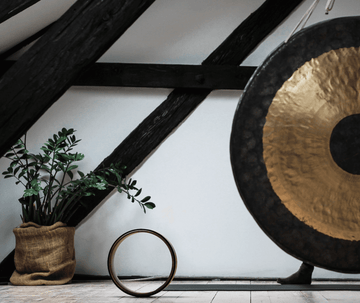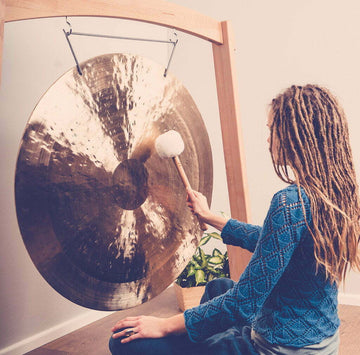
The most important facts in brief
- Gongs are basically divided into two categories: Flat gongs and humpback gongs.
- The most popular flat gongs include the TamTam gong and the Feng gong.
- Gongs differ in shape, size and material used.
- The quality and workmanship of the gong is decisive for its sound.
- The gong is very versatile: there are different areas of application in which the instrument can be an enrichment.
What is a gong and where does it come from?
The gong is an instrument that originated in Asia. It was used in rituals, ceremonies and by monks. Today, the gong can be found throughout Europe. The instrument is not only used in classical music or in the orchestra - the sound of the gong also blends harmoniously into very modern songs. It is used particularly frequently in sound work. There it provides relaxation and can bring relief from many ailments.
To find out whether the gong is basically the right instrument for you and your purposes, we have put together some classic areas of application.
Areas of application of the gong:
- Use in Peter Hess® Sound Massage and Peter Hess® Sound Methods
- Sound exercises for self-application
- Sound and fantasy journeys
- Concerts
- Support with meditation and yoga
The gong consists of a round metal plate, which can be completely flat or slightly curved. The plate is hammered, rolled and refined in a complex process. The unique tones of the gong can only be produced once all the process steps have been completed. The process is complex and also shows how much dedication and attention to detail goes into this often underestimated instrument.
Once finished, the machined metal disk is attached to a gong stand with a holder so that it can vibrate freely and the sound can develop optimally.
How to find the right gong for you
- Decide for what purpose you mainly want to use the gong.
- Listen to different gong samples online to find out which sounds and frequencies you like.
- Pay attention to quality and check the materials used and the manufacturing process in particular - both have a significant effect on the sound.
- Set a budget that you would like to invest in your new instrument.
- If you are unsure, speak to an expert and get advice on the different types of gong.
What types of gong are there?
Gongs are available in a wide range of sizes. Due to their shape and the use of different materials, they offer a very broad sound spectrum. Depending on their nature and origin, they are divided into different categories or subcategories.
These two types of gong are among the best-known instruments. As the name suggests, the flat gong has a rather flat disk, whereas the humpback gong is clearly curved in the middle.
Good to know
A basic distinction can be made between two categories: the flat gong and the humpback gong.
Tones and sound of the gong
The sound of the gong is created when you strike it in the middle or slightly offset with a gong mallet. Depending on the type of gong and the force used at strike , deep, powerful and voluminous tones or bright, clear and almost shrill tones are produced.
In Peter Hess® sound practice, gongs with a wide sound openness and sound development are used, which have a broad spectrum of frequencies and a great richness of overtones.
What is a flat gong?
The flat gong is bent at the edge and consists of a slightly curved and flat disk. Compared to the TamTam gong, however, the curvature is relatively flat, making it easier for vibrations to spread across the surface. It is struck in the middle or slightly next to it - for example with a gong reamer or gong mallet.
A flat gong is well suited for the energetic cleansing of rooms or for use in sound therapy. Its sound is voluminous and when strike struck with a soft mallet, its deep basic tone unfolds. It begins to vibrate when strike is struck hard and can develop an enormous volume.
The flat gongs are further divided into Feng gongs and TamTam gongs.
What is a TamTam gong?
The TamTam gong, also known as the Chinese temple gong, is made from a high-quality bronze alloy. In a process similar to the traditional production of a Singing Bowl - a disk is forged from a blank in an elaborate forging process.
The quality of the raw materials, the metal composition and the actual manufacturing process are decisive for the sound and vibration behavior.
The TamTam gong has a typical curved edge, which gives the gong surface its tension. This production step creates the typical sound of this instrument. There are parallels here to the tensioning of a drum.
The surface is then finished, giving the gong its typical golden ring with a black edge and black center. The basic tuning is carried out using the turned surface and targeted hammer blows in the center of the bronze disc.
TamTam gongs are available in different sizes. Instruments with a diameter of 80 to 110 cm are generally used in the Peter Hess® sound methods and on sound journeys. The sound character of the TamTam gong is very voluminous and ranges from very low to rather high tones. Different mallets can be used to elicit a wealth of different sounds, which can sometimes be reminiscent of a deep roll of thunder, the sound of entire choirs or even the song of dolphins.
At the same time, the rather centering sound of the tam-tam gong - in comparison to the feng gong - is used in a targeted manner. This powerful instrument can be made to sound quickly and is all too easy to use carelessly. However, in order to play this archaic instrument responsibly and purposefully, a thorough introduction, lots of practice and great attentiveness are required. This and a guided and reflected self-awareness is therefore an important part of our gong seminars at the Peter Hess® Institute.
Sound of the TamTam gong
- Voluminous and centering
- Ranges from very high to very low tones
- From the rumble of thunder to the singing of entire choirs

Note
Within the Peter Hess® sound methods, only Feng-Gongs made of a high-quality bronze alloy are used in order to guarantee a high-quality sound and vibration quality.
The manufacturing method also plays an important role in terms of quality. A gong made from rolled sheet bronze does not produce a usable sound quality. Therefore, only those gongs are used that are first shaped from a thick bronze plate by machine hammering and then forged and hammered by hand.
This is because the metal structure is only rolled through during the intensive forging process, which achieves the desired sound quality. The surface is then turned until the typical shiny golden appearance is achieved, to which this gong also owes another name, the "sun gong". The manufacture and shape of this instrument give it a slight spread of sound, so that it begins to vibrate strongly when played more strongly. This causes the surrounding air to move strongly and the typical "fluttering" sound spreads out.
This type of gong is available in various sizes. Feng gongs with a diameter of 40-55 cm are mainly used in the Peter Hess® sound methods.
Sound of the feng gong
- Powerful and intense
- Typical fluttery sound
What is a humpback gong?
The humpback gong, sometimes also called the Thai gong, is particularly widespread in South East Asia. It is available in different sizes and is characterized by a very distinct bulge in the middle. In contrast to the flat gong, it is only struck in the middle. Its sound is warm and calm and, in contrast to the TamTam gong, does not swell after strike but develops a muted and floating tone. In addition, the humpback gong has a certain pitch - this is expressly not desired with a flat tam-tam gong.
What types of gong are available from Peter Hess?
At Hess Sound, we offer Feng gongs and TamTam gongs in various designs so that you can quickly find the right instrument for you and your needs. All the gongs we have been selling since 1989 come from our long-standing partners and undergo several tests. Only selected instruments are sold. Gongs are valuable instruments due to the high metal prices and their elaborate manufacturing process.
In Peter Hess® sound practice, these two types of gong are used in particular. They must fulfill certain criteria that are essential for targeted use. Of course, you can also use our gongs for other purposes - be it for fantasy journeys, to accompany meditations or as a musical instrument.
Note
If you are still unsure which gong is right for you, simply contact us and let our team advise you.







